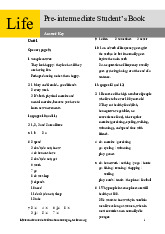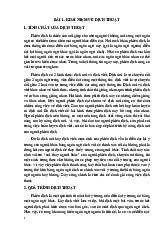




Preview text:
LESSON PLAN
TIẾNG ANH 11 FRIENDS GLOBAL UNIT 4: HOME
LESSON 4G- SPEAKING: PHOTO CONTRAST AND DISCUSSION I. OBJECTIVES
By the end of this lesson, Ss will be able to: 1. Knowledge
- Understand and use vocabulary related to accommodation for a gap year.
- Compare and contrast different ideas and options for accommodation. 2. Competences
- Engage in a discussion about accommodation for a gap year.
- Justify their opinions and provide reasons for their choices.. 3. Personal qualities
- Enhance their ability to express and defend their viewpoints.
- Demonstrate effective communication and listening skills in a group discussion.
- Be collaborative and supportive in pair work and teamwork. II. MATERIALS
- Grade 11 textbook, Unit 4, Speaking
- Computer connected to the Internet - Projector / TV - PowerPoint Unit 4G III. PROCEDURES
1. ACTIVITY 1: LEAD-IN (8 mins) a. Objectives:
- Introduce the new lesson and set the scene for Ss to acquire new language.
- Get students' attention at the beginning of the class.
- Activate Ss’ background knowledge.
- Students can gain more confidence and interest in the lesson.
- Ss have a quick look at vocabulary for identify pieces of furniture in photos. b. Content: - Battle of the Rooms. - Related vocabulary. - Exercise 1. c. Products:
- Ss work in groups, say aloud their answers, and express their opinions. d. Organisation
TEACHER’S AND STUDENTS’ ACTIVITIES CONTENT
Battle of the Rooms (3 mins) - Ss work in groups. Students’ ideas.
- Each group takes turns to say a word referring to
pieces of furniture that can be found in the living room, the kitchen, and the bedroom.
- If a group fails to say a word in 5 seconds, that group is eliminated.
- The last group remaining wins the game.
- T monitors to make sure the game is fair. Vocabulary Check (3 mins)
- T introduces the vocabulary. Words:
- T asks students which words are new to them 1. bedside table
- T checks meaning and pronunciation. 2. bookcase
- T explains the meaning of the new vocabulary by 3. bunk bed pictures. 4. curtains
- Teacher checks students’ understanding and conduct 5. cushion
oral drill chorally and individually. 6. double bed
- Ss take notes of the new vocab. 7. duvet 8. fridge 9. hook 10. kitchen cupboard 11. lamp 12. pillow
Exercise 1: Which items from below can you see in the photos? (2 mins)
- T focuses Ss’ attention on the photos.
- In pairs, students describe the furniture in the rooms.
- T elicits some descriptions and ask a few students
which room they like best and why.
bedside table, bunk bed, curtains, cushion,
double bed, duvet, fridge, hook, kitchen cupboard, lamp, pillow e. Assessment
- Teacher observes the groups and give feedback.
- T and other students give feedback to individual answers.
2. ACTIVITY 2: PRE-SPEAKING (15 mins) a. Objectives:
- Ss understand how to compare and contrast photos.
- Ss listen for preferences, and give their own opinions. b. Content: - Exercises 2-6. c. Products:
- Ss complete the exercises in the book and have some ideas for their own conversations. d. Organisation
TEACHER’S AND STUDENTS’ ACTIVITIES CONTENT
Exercise 2: Read the task above and the Speaking Strategy 1. Then listen to a student doing the
task. Which room does she prefer? Does she use any linking words when contrasting the photos? (4 mins)
- T goes through the instructions, Speaking Strategy 1 Answer: and the task. Room A
- T plays recording 2.12 for students to compare their
Yes (whereas, but, while, however, despite) ideas.
- T checks answers as a class.
Exercise 3: Choose the best linking words to complete the sentences. Then listen again and check your answers. (4 mins)
- T goes through the instructions. Answers:
- T plays the recording for students to complete their 1. whereas answers. 2. but
- With a stronger class, T could ask students to 3. While
complete the sentences before listening again to check. 4. However
- With a weaker class, T could stop the recording after 5. despite
they have heard the answer to each question.
- T checks answers as a class.
Exercise 4: Read the task above. For each of the four points, think of one advantage of staying
with a host family and one advantage of staying in university accommodation. (1 mins)
- T goes through the instructions and the task.
- T elicits ideas for the first bullet point and write them on the board.
- Working individually or in pairs, students think of one
advantage of staying with a host family and one of
staying in university accommodation for the three remaining bullet points.
- T circulates and monitor, helping where necessary.
- T asks a few students to share their ideas with the class.
Exercise 5: Listen to two students doing the task. Did they mention any of your ideas from
exercise 4? Do you agree with their opinions? Why? / Why not? (4 mins)
- T goes through the instructions. Students’ ideas
- T plays recording 2.13 for students to listen and make notes.
- T checks answers as a class.
Exercise 6: Read Speaking Strategy 2. Then complete the phrases with the words below (2 mins)
- T goes through Speaking Strategy 2 and the 1. see
instructions and make sure students understand what 2. Thinking they have to do. 3. considered
- T checks the answers as a class. 4. suppose
- T encourages students to read out the key phrases and 5. else
check pronunciation and intonation. 6. point e. Assessment
- Teacher checks students’ pronunciation and gives feedback.
- Teacher checks students’ understanding of speaking strategy.
- Teacher observes Ss’ writing of vocabulary on their notebooks.
3. ACTIVITY 3: WHILE-SPEAKING (15 mins) a. Objectives:
- Ss can ask for advice regarding accommodation.
- Ss offer their personal opinion on matters related to accommodation. b. Content: - Exercises 7 and 8. c. Products:
- Students discuss with their friends, take notes and give a talk. d. Organisation
TEACHER’S AND STUDENTS’ ACTIVITIES CONTENT
Exercise 7. Listen again to both answers. Which phrases from exercise 6 did the students use? (5 mins)
- T plays the recording again for students to tick
Let me see, That’s a good point, What else? the phrases that were used. Well, … ,
- T checks answers as a class.
Thinking about it, … , All things considered, …
Exercise 8. Work in pairs. Read the task above and make notes for each of the four points that
you have to cover. Do the task in exercise 7. (10 mins)
- T goes through the instructions and the task.
In your gap year, you are going to spend three
- Students work in pairs to make notes for the four months in the UK studying English. You are points. looking for a flat to rent.
- T circulates and monitors, helping where
Ask your friend for advice. Discuss these points: necessary. • Location
- Students practise their conversation in pairs. • Meals
- T asks a few pairs to perform their conversations • Cost for the class.
• Sharing with other students e. Assessment
- Teacher observation on Ss’ performance.
4. ACTIVITY 3: POST-SPEAKING (5 mins) a. Objectives:
- Ss can improve their speaking based on feedback. b. Content:
- T’s feedback and peer’s feedback. c. Products:
- Students take notes of their mistakes. d. Organisation
TEACHER’S AND STUDENTS’ ACTIVITIES CONTENT
Feedback and Correction (5 mins)
- T invites some students to give feedback on their
Students’ mistakes in speaking. friends’ speaking.
- T writes sentences with significant errors in them on
the board, without saying who made the errors.
- Ss identify and correct them. e. Assessment
- Teacher observation on Ss’ performance.
- Teacher’s feedback and peers’ feedback. 5. CONSOLIDATION (2 mins) a. Wrap-up
- If T is using the Classroom Presentation Tool, first do the lesson closer to review what has been covered in this lesson.
- T asks students: What have you learned today? What can you do now? and elicits answers: I
can compare ideas and justify opinions in a discussion about accommodation for a gap year. I
can use phrases that buy time for me to formulate opinions. b. Homework
- Prepare for the next lesson




